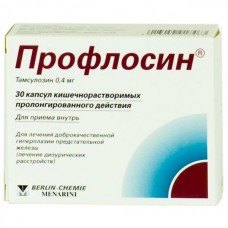Expiration date: 08/2026
Release Form
Capsules Enteric prolonged action
Composition
1 capsule contains:
Active substance: tamsulosin hydrochloride 400 mcg.
Excipients: Microcrystalline cellulose - 276.9 mg methacrylic acid-ethyl acrylate copolymer (1: 1) - 16.5 mg triethyl citrate - 1.65 mg Talc - 16.5 mg.
Composition pellet shell: copolymer of ethyl acrylate and methacrylic acid (1: 1) - 21.63 mg talc - 8.65 mg of triethyl citrate - 2.16 mg.
The composition of the capsule shell: iron oxide red dye - 0.0239 mg of titanium dioxide - 0.53 mg iron oxide yellow dye - 0.258 mg, gelatin - 38.938 mg.
Composition cap capsules: indigo carmine - 0.00152 mg, iron oxide black dye - 0.0107 mg of titanium dioxide - 0.356 mg iron oxide yellow dye - 0.114 mg, gelatin - 23.889 mg.
Packaging
30 and 100 pieces.
pharmachologic effect
pharmacodynamics
Tamsulosin selectively and competitively blocks postsynaptic ?1A-adrenergic receptors located in the smooth muscle of the prostate, bladder neck and prostatic urethra. This leads to a reduction in smooth muscle tone of the prostate, bladder neck and prostatic urethra improve urine flow.
Blockers ?-adrenergic receptors may reduce blood pressure (BP) due to a decrease in peripheral vascular resistance. However, during clinical studies with tamsulosin in patients with normal blood pressure levels, a clinically significant reduction in blood pressure was observed.
Pharmacokinetics
Suction
After oral tamsulosin is rapidly and almost completely absorbed from the gastrointestinal tract. Absorption of tamsulosin somewhat slowed down after a meal. After a single oral administration at a dose of 0.4 mg maximum concentration (Cmax) of tamsulosin in plasma is reached after about 6 hours.
Distribution
Contact with blood plasma proteins - about 99%, volume of distribution is small - 0.2 l / kg.
Metabolism
Tamsulosin is not exposed to the effect of "first pass" slowly metabolised in the liver to form the less active metabolites. Most of tamsulosin in blood is present in unchanged form. The experiment revealed the ability of tamsulosin significantly induce the activity of microsomal liver enzymes.
breeding
Tamsulosin and its metabolites are excreted primarily in the urine, 9% of the drug is excreted unchanged. The half-life (T1 / 2), tamsulosin is about 10 hours (single dose after a meal) with regular admission -13 hours.
Proflosin, indications for use
Benign prostatic hyperplasia (treatment dizuricheskih disorders).
Contraindications
- Hypersensitivity to tamsulosin or other components of the drug,
- orthostatic hypotension (including history)
- severe hepatic impairment.
Precautions: chronic renal insufficiency (creatinine clearance less than 10 ml / min), hypotension.
Pregnancy and breast-feeding
The drug is prescribed only to men.
Dosing and Administration
Inside, 1 capsule 1 time a day after breakfast or the first meal. The capsule should be swallowed whole without chewing, drinking plenty of water. The capsule should not be divided into parts or crush, as this may affect the release rate of the active ingredient. Duration of treatment is not limited.
Side effects
Possible side effects from use of the drug are listed below in descending frequency of occurrence:
frequently (<1/10,> 1/100)
uncommon (<1/100,> 1/1000)
rare (<1/1000> 1/10000)
very rare (<1/10000), including isolated reports.
Disorders of the nervous system: often - dizziness, rarely - headache, rare - fainting.
Violations by the CCC: rarely - tachycardia, orthostatic hypotension.
Disorders of the gastrointestinal tract: rarely - constipation, diarrhea, nausea, vomiting.
Violations of the reproductive system: Infrequent - abnormal ejaculation, very rarely - priapism.
Disorders of the skin and subcutaneous tissue disorders: rare - rash, pruritus, urticaria, rarely - angioedema.
Other: in some cases - the development of atonic iris syndrome (narrow pupil syndrome) during cataract surgery, fatigue, rhinitis.
special instructions
At the first signs of orthostatic hypotension (dizziness, weakness), the patient should sit or lay.
Before starting therapy with Proflosin® to exclude the presence of diseases and conditions of the patient, can determine the symptoms, similar to those of benign prostatic hyperplasia.
Before you start treatment and regularly during therapy should be performed digital rectal examination and, if necessary, to determine the concentration of prostate specific antigen (PSA).
In case of angioedema, stop therapy with Proflosin. Re-appointment of the drug is contraindicated. When surgery for cataracts in patients receiving the drug may develop iris syndrome, atonic, it is necessary to consider surgery to preoperative patient preparation and conduct of operations.
Effects on ability to drive vehicles and other machines that require high concentration of attention
Care must be taken when road management and occupations potentially hazardous activities that require high concentration and speed of psychomotor reactions, due to the fact that the possible development of dizziness.
Drug interactions
Tamsulosin does not interact with atenolol, enalapril, nifedipine and theophylline.
In an application with cimetidine was a slight increase in tamsulosin concentrations in plasma, with furosemide - decreased concentration, but it does not require dose adjustment Proflosin® drug as the drug concentration is within the normal range.
Diclofenac and Warfarin may increase the elimination rate of tamsulosin.
Co-administration of tamsulosin with other a1-adrenergic blockers may lead to lower blood pressure.
Overdose
No cases of overdose were observed while taking the drug to date. However, theoretically there is potential for a sharp decline in blood pressure and tachycardia, which may require appropriate measures. To restore blood pressure (including the orthostatic hypotension) and heart rate to normal values ??is necessary to lay the patient. Hemodialysis is impractical because tamsulosin has a high affinity for plasma proteins.
To prevent further absorption of tamsulosin advisable gastric lavage, activated charcoal or osmotic laxative (eg, sodium sulfate).
Storage conditions
Store at temperatures not above 30 ° C.
Keep out of the reach of children.
Shelf life
3 years



